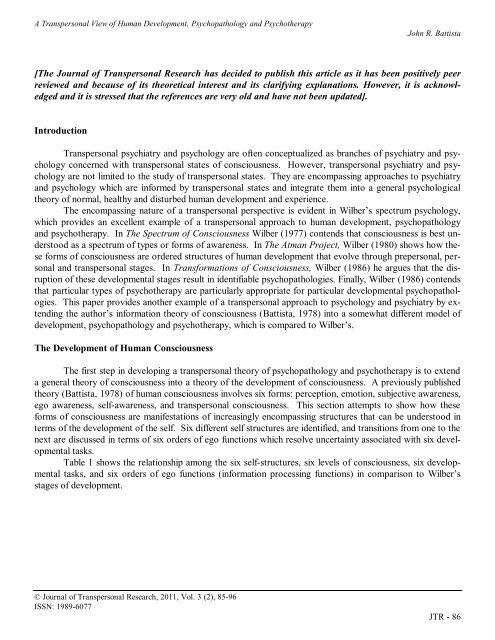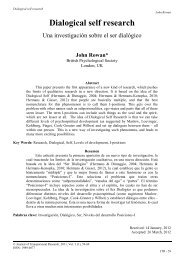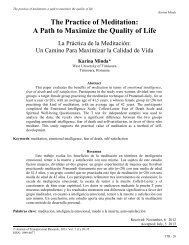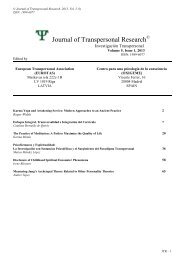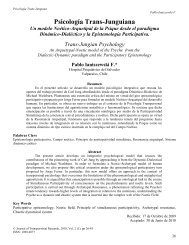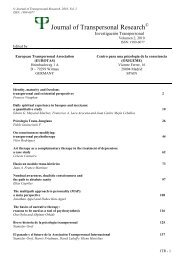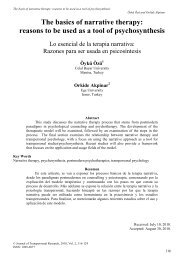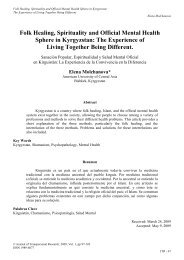John R. Battista - Journal of Transpersonal Research
John R. Battista - Journal of Transpersonal Research
John R. Battista - Journal of Transpersonal Research
You also want an ePaper? Increase the reach of your titles
YUMPU automatically turns print PDFs into web optimized ePapers that Google loves.
A <strong>Transpersonal</strong> View <strong>of</strong> Human Development, Psychopathology and Psychotherapy<strong>John</strong> R. <strong>Battista</strong>[The <strong>Journal</strong> <strong>of</strong> <strong>Transpersonal</strong> <strong>Research</strong> has decided to publish this article as it has been positively peerreviewed and because <strong>of</strong> its theoretical interest and its clarifying explanations. However, it is acknowledgedand it is stressed that the references are very old and have not been updated].Introduction<strong>Transpersonal</strong> psychiatry and psychology are <strong>of</strong>ten conceptualized as branches <strong>of</strong> psychiatry and psychologyconcerned with transpersonal states <strong>of</strong> consciousness. However, transpersonal psychiatry and psychologyare not limited to the study <strong>of</strong> transpersonal states. They are encompassing approaches to psychiatryand psychology which are informed by transpersonal states and integrate them into a general psychologicaltheory <strong>of</strong> normal, healthy and disturbed human development and experience.The encompassing nature <strong>of</strong> a transpersonal perspective is evident in Wilber’s spectrum psychology,which provides an excellent example <strong>of</strong> a transpersonal approach to human development, psychopathologyand psychotherapy. In The Spectrum <strong>of</strong> Consciousness Wilber (1977) contends that consciousness is best understoodas a spectrum <strong>of</strong> types or forms <strong>of</strong> awareness. In The Atman Project, Wilber (1980) shows how theseforms <strong>of</strong> consciousness are ordered structures <strong>of</strong> human development that evolve through prepersonal, personaland transpersonal stages. In Transformations <strong>of</strong> Consciousness, Wilber (1986) he argues that the disruption<strong>of</strong> these developmental stages result in identifiable psychopathologies. Finally, Wilber (1986) contendsthat particular types <strong>of</strong> psychotherapy are particularly appropriate for particular developmental psychopathologies.This paper provides another example <strong>of</strong> a transpersonal approach to psychology and psychiatry by extendingthe author’s information theory <strong>of</strong> consciousness (<strong>Battista</strong>, 1978) into a somewhat different model <strong>of</strong>development, psychopathology and psychotherapy, which is compared to Wilber’s.The Development <strong>of</strong> Human ConsciousnessThe first step in developing a transpersonal theory <strong>of</strong> psychopathology and psychotherapy is to extenda general theory <strong>of</strong> consciousness into a theory <strong>of</strong> the development <strong>of</strong> consciousness. A previously publishedtheory (<strong>Battista</strong>, 1978) <strong>of</strong> human consciousness involves six forms: perception, emotion, subjective awareness,ego awareness, self-awareness, and transpersonal consciousness. This section attempts to show how theseforms <strong>of</strong> consciousness are manifestations <strong>of</strong> increasingly encompassing structures that can be understood interms <strong>of</strong> the development <strong>of</strong> the self. Six different self structures are identified, and transitions from one to thenext are discussed in terms <strong>of</strong> six orders <strong>of</strong> ego functions which resolve uncertainty associated with six developmentaltasks.Table 1 shows the relationship among the six self-structures, six levels <strong>of</strong> consciousness, six developmentaltasks, and six orders <strong>of</strong> ego functions (information processing functions) in comparison to Wilber’sstages <strong>of</strong> development.© <strong>Journal</strong> <strong>of</strong> <strong>Transpersonal</strong> <strong>Research</strong>, 2011, Vol. 3 (2), 85-96ISSN: 1989-6077JTR - 86


